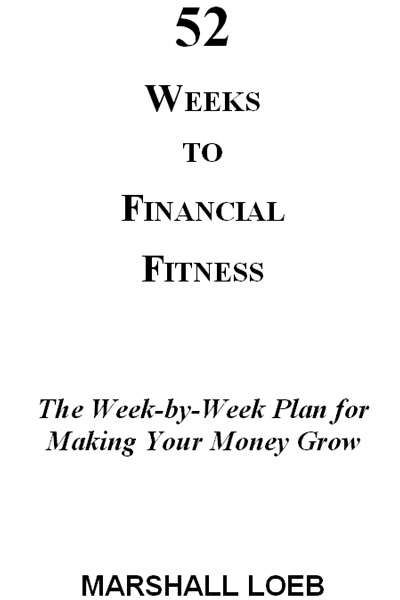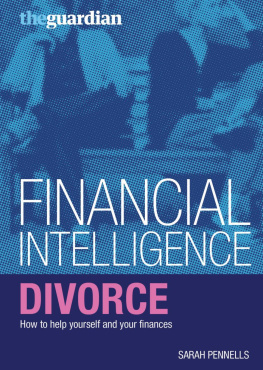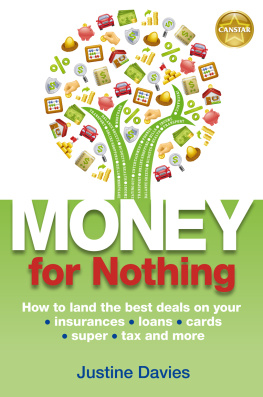

For Peggy, Michael, Margaret, Marjorie, Michael II, Katie, Caroline, Jeremy, Marc...
and More TK
ACKNOWLEDGMENTS
M any talented and dedicated people helped me in creating this book, and I am profoundly grateful to all of them:
Frank Merrick, my longtime friend and colleague at Money and Time magazines, brought his deep knowledge and exceptional writing skills to the job of helping draft many of the chapters.
John Mahaney, an editor and a gentleman, gave me great encouragement in this work, kept me on schedule and, in all, distinctly enhanced the book.
John Castro, ably aided by editorial assistant Elizabeth Carson, did a remarkably thorough job of fact-checking the entire manuscript, running down countless sources, and never hesitating to challenge the author. He also made numerous valuable editorial suggestions.
Elyssa Folk, who has a brilliant journalistic career ahead of her, contributed to several chapters and largely wrote Week 9, Master the Computer, a subject in which she is an expert.
Maryan Malone smoothly handled the copy-editing and made many useful suggestions.
Michele Perri, efficiency expert extraordinaire, helped me organize and keep track of the material that went into the 52 chapters.
Warren M. Bergstein, Certified Public Accountant and professor of accounting and taxation at Long Island University, was a sure-footed guide through the maze of tax law, expertly and patiently answering our endless questions.
Im also deeply appreciative for the major editorial contributions made by Glenn Daily on insurance; Denise Topolnicki on wills and trusts; and Emily Andren on powers of attorney.
Among the professional financial advisers and tax experts who made significant contributions were Lu Anne Morrison, Randy Siller, Stanley Altmark, Jim Weikart, and Richard Prince. The lawyers to whom Im grateful are Alan Kroll, Gary Greenberg, and Harry Peden.
Alexandra Lebenthal, Jim Lebenthal, and Barry Bostwick illuminated the subject of tax-free bonds for me.
Other important contributions were made by Greg McBride and John Schaffer at bankrate.com; Peter Hollenbach and Sheila Nelson of Bureau of the Public Debt; Susan Stawick of the Internal Revenue Service; Mark Rosen of the Consumer Credit Counseling Service; Louise Meng, Sonia Ordenes-White, and Mary Lee Kingsley of the Bank-Fund Staff Federal Credit Union; Amy Plympton of LIMRA; Dean Maki and David Brown of the Federal Reserve Board; Professors John Langbein of Yale and Richard Wellman of the University of Georgia; Karen McKenzie of the Urban Institute; Russ Podhurst of Atlantic Business Association; Salvatore Costa of the Sterling National Bank; Keith Gumbinger of HSH Associates; and Jason Zweig of Money magazine.
A very personal thanks goes to Roger Donald, a book editor with a fine knack for picking winners, for his consistent confidence in this project.
Finally, the title for this book arose from an expansive dinner that Peggy Loeb, my ever-patient roommate, and I had with our children, Michael and Margaret. I dont recall which of them came up with the ultimate wording, so I credit, and thank, each and all of themfor that, and so much, much more.
M.L.
CONTENTS
INTRODUCTION
L ook at this book as your personal traineryour friendly, expert, immediately useful, personal trainer.
You know that the time has come to get into better shape, financially.
For most people, just getting started is the hard part. But once you're on your way, you'll wonder how you ever performed at your peak without your personal trainer.
No matter what kind of condition you're in now, your trainer willweek by weekcarefully bring you to the next level.
In sum, your trainerthis bookwill show you, step by step, how you can become financially fit. Every week, you will have a measurable and reasonable task that you can accomplishor at least get a good start on.
The first week out, we'll get you to perform a little work on the treadmill. We'll do simple things like making sure that you are collecting the highest interest available on your savings and checking accounts. Then, a short time later, we'll go into a bit of weight training by having you learn to use some personal finance software. Soon after that, we'll make sure you are putting your money into the right IRA for your circumstances. Next, we'll do some heavier lifting by pursuing some profitable strategies for buying stocks and reinvesting dividends.
There's nothing extreme hereno Triathlon spurts of futures or options. You don't have to take those kinds of risks.
Getting your personal finances into good long-term shape is a demanding and often daunting job. But the work needed is much easierand you are more likely to succeedif you do one task at a time.
We have divided your job of effecting a financial plan into 52 pieces, one week each. We do not expect you to complete everything involved with each task in just one week. We do expect that you will get a strong start on it, while recognizing that you will have to continue pursuing each specific goal for a long while to come.
As you follow the practical suggestions in this book, you will feel better with every passing day. At the end of 52 weeks, you should have considerably greater control of your finances. And you can build from there. Staying fit will be something that you work at every dayprofitablyfor the rest of your life.

W EEKS
TO
F INANCIAL
F ITNESS
WEEK

Score Some Quick Wins
W ho says there are no second chances? Every dawning day gives us all a fresh start, a new opportunity to begin making all the moves needed to get our finances in shapeat last! Remember: Its seldom too late, and never too early, to start investing and saving intelligently, and to take other steps that are necessary to improve your financial health.
Let me share with you 10 of the most important steps Ive learned over the years. Several may sound familiar to you; together, they create a useful checklist of sensible moves toward financial security. Consider them as a few quick hitsways to make or save money immediately. All of themand much morewill be detailed in the pages of this book. Start taking one or more of these steps this week, then follow up with others in subsequent weeks.
Step 1
Visit your bank and find out how much interest youre collecting on your checking, savings, and other accounts. Ask a bank officer how you can collect a somewhat higher rate of interest. Many banks and savings institutions pay their bigger savers more; you may be able to get an extra point or so tacked onto your savingsjust for asking. After all, youre a good customer, and the bank wants to keep your business. Perhaps you can switch your cash from an ordinary savings account to a higher-yielding bank money market account or even a short-term certificate of deposit (CD). If you have $5,000 or more to put into a CD, ask your banker whether that will qualify you for a special bonus rate.
Step 2
Before your next payday, arrange with your bankor your employerto have a fixed amount deducted from every paycheck and deposited into your savings or investment account. Often, a bank will automatically transfer money$25 or more each monthfrom your checking account to a stock mutual fund of your choice. Usually, theres no fee for this service.
Next page







